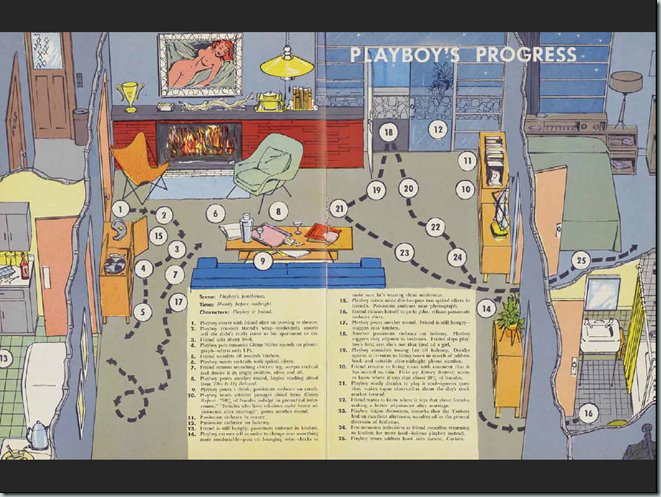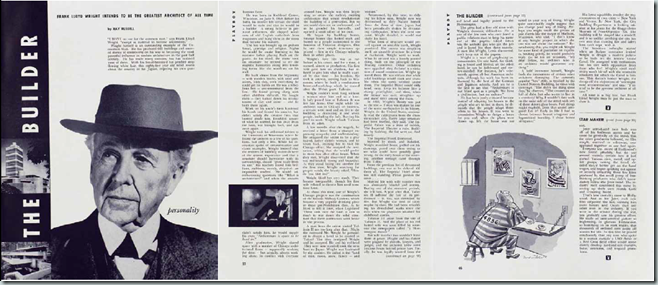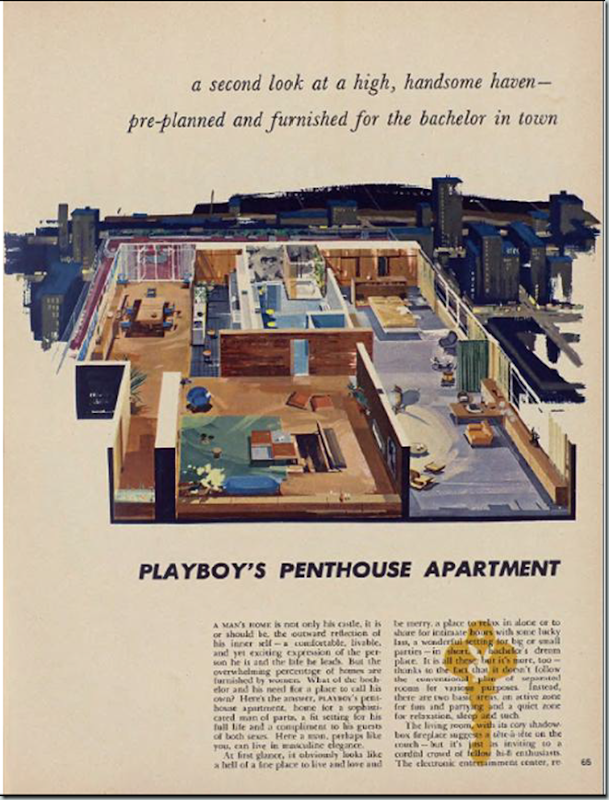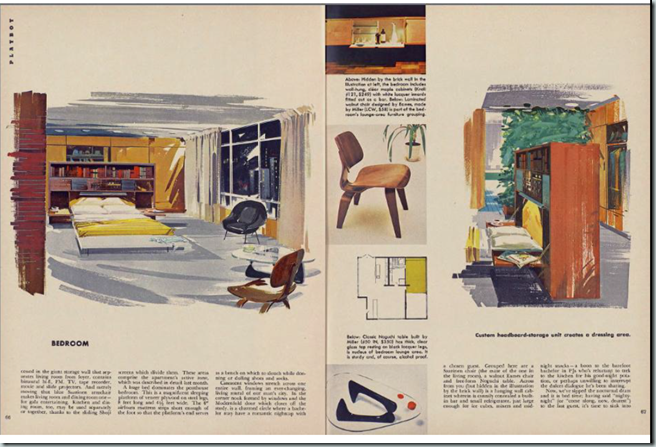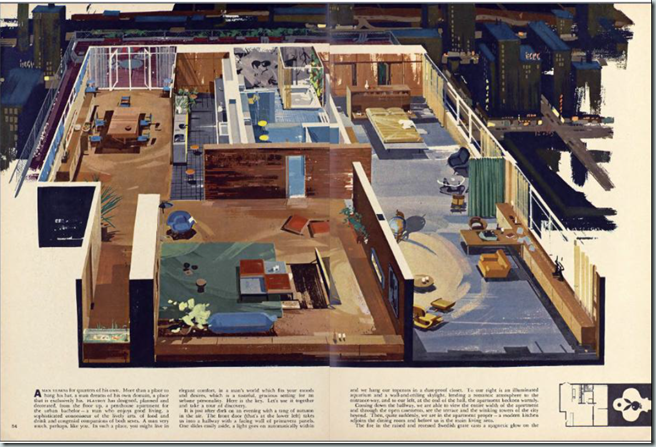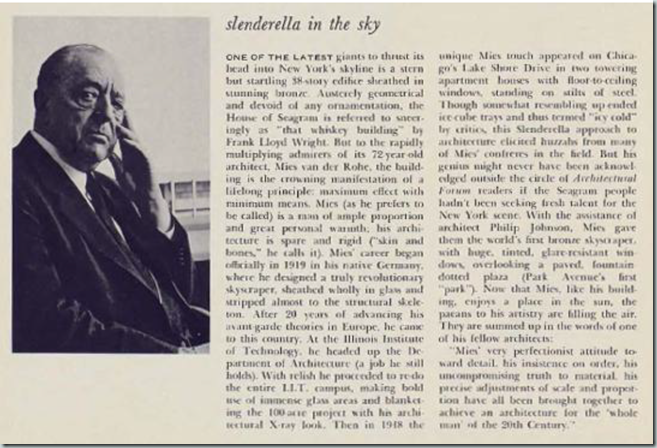English behind
Del 29 de Septiembre del 2012 al 10 de Febrero 2013.
En NAiM/Bureau Europa | Avenue Ceramique 226 | Maastricht, Netherlands
La exposición se centra en cómo la revista Playboy ha desplegado arquitectura y diseño para dar forma a una nueva identidad para el hombre americano. La exposición ha sido preparada en estrecha colaboración con el programa de doctorado de la Escuela de Arquitectura y Medios de Comunicación y el programa de la modernidad en la Universidad de Princeton, sobre la base de un proyecto de investigación de tres años dirigido por la profesora Beatriz Colomina.
Si la arquitectura se erigió en la capacidad de mejorar las condiciones estéticas y de habitabilidad de una construcción. La difusión de contenidos ha mejorado su estética funcional a la mas amable de las caras, uniendo -como de un complemento se tratara- su aspecto mas sexy de todos los tiempos. Si la tentación y máximo deseo de la humanidad era dar cobijo a la especie, la reproducción no podía situarse muy lejos de esta nueva clase gobernante que giraba en torno a la nueva industria.
Este rol se juega de manera continuada en un estudio de la modernidad en su mas cercano aspecto mediático. ¿Es posible algo mas allá del deseo que lo mediático para un arquitecto? Entre lo estético y funcional, vestir el entorno con la belleza natural.
El sexo, la arquitectura y el diseño: desde el comienzo mismo se entrelazan inextricablemente en las páginas de la revista erótica de fama mundial Playboy. Se extiende a brillantes entrevistas, artículos, dibujos que ofrecen un arsenal de arquitectos como Frank Lloyd Wright, Mies van der Rohe, Buckminster Fuller, Moshe Safdie, Soleri Paolo, Antfarm y Archizoom, junto con las fotografías de las mujeres perfectas sensuales y las páginas centrales famosas por su clímax, creó un cóctel revolucionario y seductor para sus lectores masculinos.
La exposición Playboy Arquitectura, 1953-1979, muestra cómo la arquitectura y el diseño han desempeñado un papel crucial en el mundo de la fantasía y a la inversa como Playboy llegó a influir en el mundo de la arquitectura. El historiador de la arquitectura Sigfried Giedion caracteriza la arquitectura de los años sesenta como Playboy Arquitectura: "Corriendo de una sensación a otra y te aburre rápidamente" Su colega Reyner Banham, por su parte, vio en la combinación de Playboy con gadgets, pin-ups y la cultura popular "uno de los mejores regalos de los Estados Unidos a la cultura occidental", proclamando "Voy a rastrear una milla para Playboy."
La exposición muestra fotografías originales y películas, publicados y no publicados representaciones arquitectónicas, objetos de diseño, entrevistas con los arquitectos y redactores, y los entornos inmersivos. La instalación dinámica de artefactos traza arquitectura del playboy, de la seducción desde el inicio de la revista en 1953 hasta la década de 1970, cuando su enorme número total de lectores comenzó a transformar la fantasía de Playboy en realidad – el apoyo de la propia cadena de Playboy de clubes y resorts, películas populares y programas de televisión.
La exposición muestra cómo Playboy introdujo la arquitectura moderna para el público de masas en la era de la Guerra Fría, los disturbios políticos, el surgimiento del feminismo, la píldora, y acalorados debates sobre la arquitectura moderna. Arquitectura y diseño se utiliza para remodelar la masculinidad – supuestamente la liberación del hombre americano de los grilletes de la vida familiar suburbana para darle la oportunidad de darse vuelta en un diseño inteligente deseado ardientemente la soltería urbana – un precursor de la revolución sexual de la década de 1960. Revolución sexual y la revolución arquitectónica eran inseparables.
La exposición Playboy Arquitectura 1953-1979 ha sido comisariada por Beatriz Colomina, Eversole Britt, Handwerker Margo y Vannucchi Federica con un equipo de investigación con Pep Avilés, José Bedford, Britz Marc, Fabricio Daniela, Olaiya Yetunde, Ramírez Enrique, Ricchi Daria, Steenson Molly y Vanessa Grossman.
Bájate el dossier de Princeton University
+ Información:
………………………………………………………………………………………………………………………………………………….
29 September 2012 – February 10, 2013
At NAiM/Bureau Europa | Avenue Ceramique 226 | Maastricht, Netherlands
The exhibition focuses on how the magazine Playboy deployed architecture and design to shape a new identity for the American man. The exhibition has been prepared in close collaboration with the Ph.D. program of the School of Architecture and the Media and Modernity program at Princeton University on the basis of a three-year research project led by Professor Beatriz Colomina.
Sex, architecture and design: from the very start they were inextricably intertwined in the pages of the world-famous erotic magazine Playboy. Interviews, articles, drawings, and glossy spreads featuring an array of architects including Frank Lloyd Wright, Mies van der Rohe, Buckminster Fuller, Moshe Safdie, Paolo Soleri, Antfarm and Archizoom, along with the perfected photographs of sensual women and the famous centerfold as the climax, created a revolutionary and seductive cocktail for its masculine readers.
The exhibition Playboy Architecture, 1953-1979 shows how architecture and design played a crucial role in the Playboy fantasy world and in reverse how Playboy came to influence the world of architecture. The architectural historian Sigfried Giedion characterized the architecture of the sixties as Playboy Architecture: “Rushing from one sensation to another and rapidly bored.” His colleague Reyner Banham, on the other hand, saw in Playboy’s combination of gadgets, pin-ups and popular culture “one of the greatest gifts to America and to Western culture,” proclaiming “I will crawl a mile for Playboy.”
The exhibition features original photographs and films, published and unpublished architectural renderings, design objects, interviews with architects and editors, and immersive environments. The dynamic installation of artifacts traces Playboy’s architecture of seduction from the magazine’s inception in 1953 through the 1970s, when its huge readership began transforming the Playboy fantasy into reality – supported by Playboy’s own chain of clubs and resorts, popular movies and television shows.
The exhibition demonstrates how Playboy introduced modern architecture to the mass public in an era of Cold War, political unrest, the emergence of feminism, the pill, and heated debates on modern architecture itself. Architecture and design were used to reshape masculinity – supposedly liberating the American male from the fetters of suburban family life to give him the chance to turn himself into a hotly desired design savvy urban bachelor – a precursor of the sexual revolution of the 1960s. Sexual revolution and architectural revolution were inseparable.
The exhibition Playboy Architecture 1953-1979 has been curated by Beatriz Colomina, Britt Eversole, Margo Handwerker and Federica Vannucchi with a research team including Pep Aviles, Joseph Bedford, Marc Britz, Daniela Fabricius, Yetunde Olaiya, Enrique Ramirez, Daria Ricchi, Molly Steenson and Vanessa Grossman.
The theme designated for the Program in Media and Modernity for the academic year 2008-09 is "Architecture in Playboy: 1953-1979." The thesis of this research seminar is that Playboy played a crucial yet unacknowledged role in the cultivation of design culture in the USA. Through a wide range of different strategies, the magazine integrated state of the art designers and architects into a carefully constructed vision of a desirable contemporary life style. The seminar will explore the ways in which Playboy was ahead of professional and popular magazines in promoting modern architecture and design. The collaborative research seminar, assembles and analyzes the magazines, the secondary literature on Playboy, the related archives, and conducts interviews with protagonists. As in previous Media and Modernity research seminars, the project will culminate in the collaborative production of a definitive book, exhibition, or event, to be determined as the project evolves.
Playboy Research Team
Joseph Bedford, Britt Eversole, Daria Ricchi, Vanessa Grossman, Marc Britz, Daniela Fabricius, Margo Handwerker, Yetunde Oliaya, Federica Vannucchi, Pep Aviles, Enrique Ramirez and Molly Steenson
Bibliography
- Bruegmann, Robert, Holabird and Roche. An Illustrated Catalogue of Works. Volume II, 1911-1927, New York & London: Garland Publishing, Inc, 1991, pp. 414-424.
- Reyner Banham, "I’d Crawl a Mile for Playboy" in Architect’s Journal, Vol.131, p.527-529, (April, 7), 1960. Republished in Penny Sparke, Reyner Banham, Desing by Choice, Rizzoli International, 1981, p.130
- "A Home is Not a House" in Art in America, Vol. 53, (April 1965), p.70-79. Republished in Penny Sparke, Reyner Banham, Desing by Choice, Rizzoli International, 1981, pp. 56-60
- "Horse of a Different Colour", in New Society, Vol. 10, n?266, (November 2 1967), pp.636-637.Republished in Penny Sparke, Reyner Banham, Desing by Choice, Rizzoli International, 1981, pp.127-129
- "Triumph of Software", in New Society, Vol.12, n?318, (October, 31, 1968), pp.6292-630. Republished in Penny Sparke, Reyner Banham, Desing by Choice, Rizzoli International, 1981, pp.133-136
- Editorial, "Playboy-Architektur", in Deutsche Bauzeitung, n? (February 1964), pp.75-77.
- Editorial, "Playboy: Allusions to City Tastes in a Country Setting" in Architectural Record, (December 1969), pp.128-129
- Editorial, "The world of Ivan and Peter Chermayeff" in Space Design, n? 11 (November 1976), p.5-65
- Sigfried Giedion, "Architecture in the 1960’s. Hope and Fears" in Space, Time and Architecture, thirteenth printing, 4th enlarged edition, Cambridge, MA: Harvard University Press, 1962, pp.xxxi–lvi
- "Sigfried Giedion. On Playboy Architecture", Architectural Forum, Vol., 117, (July 1962), pp. 116-117
- Charles Jencks, Modern Movements in Architecture, 2nd Edition, London: Penguin Books, 1985.
- The New Paradigms in Architecture. The Language of Post-modernism, New Heaven: Yale University Press, 2002.
- Robert Jensen, "Resort Hotels: Symbol and Association in Their Design" in Architectural Record, (December 1969), pp.119-123
- Colin Rowe, Fred Koetter, "After the Millenium", in Collage City, Cambridge, MA; London: The MIT Press, 1978, pp.32-49.
- "’BAU-‘Interview mit Claes Oldemburg", in Bau, Schrift fur Architektur und Stadtebau, (April 1966), p.83-87
- "Lightweight, nailable framing speeds construction of resort Hotel" in Architectural Record, (August 1971), p. 127
- "Playboy Towers" in Interior Design, (October 1971), pp.132-135
Download Princeton University Dossier
For more information visit
http://www.bureau-europa.nl/en/manifestations/playboy_architecture_1953_1979/










